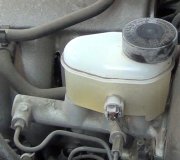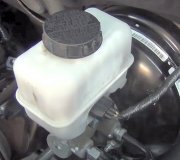Remove the cap on the brake fluid reservoir, then try to sight down through the fluid to either of the two ports. Have a help work the brake pedal down a couple of inches, then back up. Watch for any tiny air bubbles popping up out of those ports when the pedal is released. If you see any, there is still air in the system that is working its way back up to the reservoir.
Probably the biggest issue has to do with the miserable rear caliper design. This was used by GM and Ford for decades but they recently switched to the much better Chrysler design. Chrysler however, switched to the GM/Ford design that puts the parking brake assembly in the caliper. If air got pushed through the system after replacing the master cylinder, it can become trapped in the rear pistons. You will need to remove them, hold the hose port up, then fill the calipers with brake fluid from a bottle.
If air in the rear calipers is not a good suspect, it is still necessary to manually adjust the pistons. That is done by working the parking brake repeatedly to adjust the pistons out. These do not self adjust by working the brake pedal like they do on the front.
The next time you need to replace a master cylinder, it is counter-productive to bleed at the wheels. No air gets into the lines if there was no leak, so pushing air all the way to the calipers gives it plenty of chance to become trapped somewhere. I can provide more details, but I just bleed at the lines where they connect to the master cylinder. That saves a real lot of time.
Tuesday, March 20th, 2018 AT 3:18 PM



